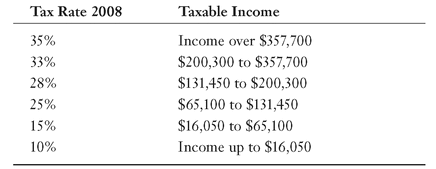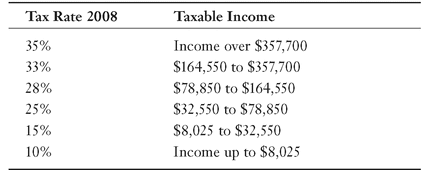Just the Facts
IRAs are great tax savers because the earnings in your account are tax-deferred until you withdraw them. That means every dollar stays invested—earning you returns—and is never withdrawn to pay taxes.
The special tax features of IRAs make them an entirely different breed of account from regular savings or plain investment accounts. These differences affect when you’ll owe taxes on your account earnings and the tax rate you’ll have to pay. To understand how this works, you need to understand a few tax terms:
• Taxable income These are earnings from your job and from interest or dividends from your investments that you have to pay tax on each year.
• Income tax rate This is the percentage of your income that you’re required to pay to your local, state, or federal government. Tax rates are divided into brackets that start low for low-income earners and increase as one’s income rises in a pattern that looks like an inverted pyramid.
Married, Filing Jointly


Rainy Days
In 2008, all states except Alaska, Florida, Nevada, New Hampshire, South Dakota, Tennessee, Texas, Washington, and Wyoming had income taxes that could affect withdrawals from your IRAs. In this book, we only deal with federal taxes, so check with your state revenue department to learn how state laws affect you and your accounts.
Single Filers

• Marginal tax rate This is the rate on the highest bracket your income reached. Your marginal rate is the rate at which one extra dollar of new taxable income will be taxed. New income could include withdrawals that you make from your IRA, so knowing what their bracket is and how it affects you is important. For example, using the preceding tables, if you were a single filer in 2008 and had $45,000 in taxable income, your marginal tax rate would be 25 percent.
• Adjusted gross income (AGI) AGI is calculated by adding your work income plus other income such as investment interest and dividends or alimony. From that total, subtract exclusions like alimony you paid and the cost of health insurance if you’re self-employed. One reason you should know your AGI is to be sure you’re eligible to make certain types of IRA contributions.
• Capital gains tax rate This is the percentage of your investing profits that you must pay in taxes. If you sell an investment that you have held for a year or longer for more than you paid for it, you’ve made a profit or a capital gain. The tax law is written to encourage you to invest by making this tax rate lower than the rate you pay on income. For 2008, if your marginal tax bracket is 15 percent or less, then your capital gains rate is 0 percent. Taxpayers in the higher brackets pay a 15 percent capital gains rate, even though their income tax rate may be 25 percent or higher.
• Tax-deferred account Income or capital gains generated by investments in these accounts aren’t taxable right away. They’re deferred into the future, and taxes are often then owed on the amount withdrawn from the account.
• Tax-deductible When it relates to retirement accounts, tax-deductible means you get to reduce your taxable income by the amount you deposit in your retirement account/s. This doesn’t reduce your tax liability dollar-for-dollar, but it is a big tax saver because it reduces the amount of income subject to your marginal tax bracket.
• Contributions The amount you deposit into your retirement account/s.
• Withdrawals The amount you take out of your retirement account/s.
• Tax year The rules controlling all retirement accounts including IRAs are based on tax years. This means your eligibility to contribute to an account is determined each year depending on a variety of factors, including your MAGI for the year and whether or not you have a retirement plan at work.
• After-tax dollars If your contribution to an IRA is made in after-tax dollars, it means you didn’t get to deduct that amount from your taxable income. This could happen if you’re ineligible to make deductible contributions to your Traditional IRA account (keep track of your contributions when you file your taxes with form 8606 in this case) or if you’re contributing to a Roth account.
• Pretax dollars Investing pretax dollars means you can deduct the amount you deposited in the IRA from your taxable income. This money is “pretax” because getting the deduction means you haven’t paid income taxes on those dollars yet—they’re deferred.
When You Can Add to Your IRA
Retirement accounts can belong only to an individual. They can’t be owned jointly by two people, and they can’t be owned by a nonperson, like a trust. If you’re married, each person can have an IRA and make a contribution to his account if:
• At least one spouse had taxable employment income for that tax year.
• The IRA account owner was younger than 70 ½ for the whole year.
Both spouses can contribute separately up to the IRA limit or their total earned income, whichever is less. If this seems like a lot to figure out, don’t worry—the IRS gives you a little extra time to sort it all out. Although you can make contributions to your IRA throughout the year, you don’t have to make final contributions until the tax deadline—April 15 of the following year or the next weekday if the 15th falls on a weekend.

Nest Eggs
Do you have a detailed question about IRAs or want to check into more specific examples? Check out IRS Publication 590 at www.irs.gov for all the specific rules regulating IRAs.

Rainy Days
Your annual contribution limit applies to all your IRA accounts, not each individual account if you have several. The IRS only limits total contributions; you’ll be penalized for overcontributing, but you won’t be penalized if you can’t contribute up to the maximum allowed. If you discover you’ve overcontributed for the year, you won’t be penalized if you withdraw the excess before you file your tax return.
IRA contributions are a use-it-or-lose-it proposition; you either make your contribution for the tax year or you don’t. You can’t deposit an amount this year that you were eligible to deposit for the previous tax year. To help you build your nest egg, the limits on what you can contribute annually are increasing, though. In 2008, you could deposit up to $5,000 into your IRA account. If you’re age 50 or over, you can add a catch-up amount of $1,000 for a total of $6,000. Under current tax law, this catch-up amount is expected to stay level at $1,000 per year, while the basic contribution amount of $5,000 will be adjusted for inflation in 2009 and beyond.
To Deduct or Not to Deduct
Depending on your circumstances, you may be able to deduct the amount you put into your IRA account from income on your tax return. Whether or not you can take the deduction depends on your modified AGI and on whether you or your spouse had a plan at work. Modified AGI is your ordinary adjusted gross income, with a few adjustments that affect very few people. Following are the limits for 2008 that apply to single people and most married people. Check IRS publication 590 for updated limits for future years or for the limits if you’re married but filing your tax return separately from your spouse.
How much can you deduct if you ARE covered by a plan at work?
If you’re filing single, head of household, and your modified AGI is:
$53,000 or less
$53,001 to $63,000
$63,001 or more
$53,001 to $63,000
$63,001 or more
Full deduction
Partial deduction
No deduction
Partial deduction
No deduction
If you’re filing married, filing jointly, or qualifying widow(er), and your modified AGI is:
$85,000 or less
$85,001 to $105,000
$105,001 or more
$85,001 to $105,000
$105,001 or more
Full deduction
Partial deduction
No deduction
Partial deduction
No deduction
How much can you deduct if you’re NOT covered by a plan at work?
If you’re filing single, head of household, qualifying widow(er), and your modified AGI is:
Any amount
Full deduction
If you’re filing married, filing jointly, and spouse DOES NOT have a plan at work, and your modified AGI is:
Any amount
Full deduction
If you’re filing married, filing jointly, and spouse DOES have a plan at work, and your modified AGI is:
$159,000 or less
$159,001 to $169,000
$169,001 or more
$159,001 to $169,000
$169,001 or more
Full deduction
Partial deduction
No deduction
Partial deduction
No deduction
Withdrawal Time
You can withdraw money from your IRA anytime you want, but IRS rules encourage you to delay at least until you’re older by putting an additional 10 percent penalty on withdrawals that are not “qualified.”
The most common situations that would make an IRA withdrawal qualified are that you’re:
• Age 59½ or older
• Disabled or you’ve died and your beneficiary is receiving the proceeds of your IRA
• Using your withdrawals to pay for college or other qualified higher education expenses
• Using a withdrawal or up to $10,000 toward a first-time home purchase

Rainy Days
You can name a beneficiary who will collect the proceeds from your IRA when you die. It’s important to keep your beneficiary designations up-to-date because IRA beneficiaries receive their inheritance regardless of what your will says.
When you do take IRA withdrawals, either qualified or not, at least a portion is taxed at income tax rates no matter whether the investments in the account grew because of interest or capital gains. What if you decide you like deferring your taxes and don’t need the money in your IRA? Uncle Sam won’t wait forever for you to start taking withdrawals and paying income taxes on your money. He mandates that you begin making withdrawals by April 1 following the year you turn 70½.
..................Content has been hidden....................
You can't read the all page of ebook, please click here login for view all page.
